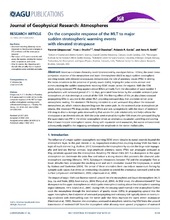| dc.contributor.author | Limpasuvan, Varavut | |
| dc.contributor.author | Orsolini, Yvan | |
| dc.contributor.author | Chandran, Amal | |
| dc.contributor.author | Garcia, Rolando R. | |
| dc.contributor.author | Smith, Anne K. | |
| dc.date.accessioned | 2016-08-31T12:31:23Z | |
| dc.date.available | 2016-08-31T12:31:23Z | |
| dc.date.issued | 2016-05 | |
| dc.Published | Journal of Geophysical Research - Atmospheres 2016, 121(9):4518-4537 | eng |
| dc.identifier.issn | 2169-8961 | en_US |
| dc.identifier.uri | https://hdl.handle.net/1956/12699 | |
| dc.description.abstract | Based on a climate-chemistry model (constrained by reanalyses below ~50 km), the zonal-mean composite response of the mesosphere and lower thermosphere (MLT) to major sudden stratospheric warming events with elevated stratopauses demonstrates the role of planetary waves (PWs) in driving the mean circulation in the presence of gravity waves (GWs), helping the polar vortex recover and communicating the sudden stratospheric warming (SSW) impact across the equator. With the SSW onset, strong westward PW drag appears above 80 km primarily from the dissipation of wave number 1 perturbations with westward period of 5–12 days, generated from below by the unstable westward polar stratospheric jet that develops as a result of the SSW. The filtering effect of this jet also allows eastward propagating GWs to saturate in the winter MLT, providing eastward drag that promotes winter polar mesospheric cooling. The dominant PW forcing translates to a net westward drag above the eastward mesospheric jet, which initiates downwelling over the winter pole. As the eastward polar stratospheric jet returns, this westward PW drag persists above 80 km and acts synergistically with the return of westward GW drag to drive a stronger polar downwelling that warms the pole adiabatically and helps reform the stratopause at an elevated altitude. With the polar wind reversal during the SSW onset, the westward drag by the quasi-stationary PW in the winter stratosphere drives an anomalous equatorial upwelling and cooling that enhance tropical stratospheric ozone. Along with equatorial wind anomalies, this ozone enhancement subsequently amplifies the migrating semidiurnal tide amplitude in the winter midlatitudes. | en_US |
| dc.language.iso | eng | eng |
| dc.publisher | Wiley | en_US |
| dc.title | On the composite response of the MLT to major sudden stratospheric warming events with elevated stratopause | en_US |
| dc.type | Peer reviewed | |
| dc.type | Journal article | |
| dc.date.updated | 2016-08-24T12:07:19Z | |
| dc.description.version | publishedVersion | en_US |
| dc.rights.holder | Copyright 2016 American Geophysical Union. All Rights Reserved | en_US |
| dc.identifier.doi | https://doi.org/10.1002/2015jd024401 | |
| dc.identifier.cristin | 1368577 | |
| dc.relation.project | Norges forskningsråd: 223252 | |
